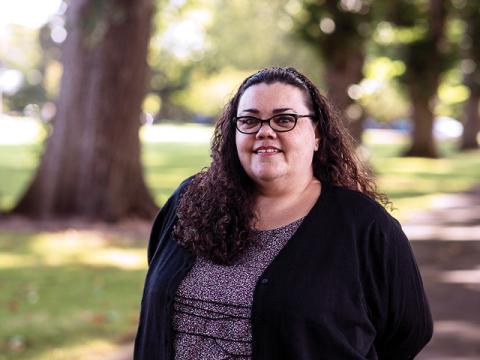Equity Matters — in life, and in death.
With dignity and respect — this is the way we all hope to be treated in our lifetimes. But what about after we pass? Who advocates for us then, when we can no longer speak for ourselves?

As the Office of Institutional Diversity’s Native American Graves Protection and Repatriation Act coordinator, Dawn Marie Alapisco acts as one such advocate, preserving the rights of Indigenous ancestors temporarily in the care of Oregon State University and ensuring equity prevails, even after death. Keep reading to hear more of her story.
Q: What brought you to Oregon State?
A: I came to OSU as a student in 2008...more years ago than I really want to admit. At the time, I planned to get my advanced nursing degree, only to fall in love with anthropology. It gave me the opportunity to be as fastidious as I needed to be and gave me enough variability that I knew I wouldn’t get bored.
Oregon State was the first place where I felt I belonged. Being both biracial and a dwarf impacted by Autism Spectrum Disorder, Type 1 Diabetes and congenital skeletal abnormalities, that is truly meaningful in both my personal life and in my professional development.
Q: What are your responsibilities in OID?
A: As the Native American Graves Protection and Repatriation Act Coordinator, I wear many hats — curator, cultural resources manager, bioarchaeologist and tribal liaison, just to name a few. I primarily work with the 574 federally recognized tribes in the United States to find cultural affiliation for any native human remains and cultural items in OSU’s care. And I try and get them home to their tribes as expediently as possible.
Q: Why is this work meaningful to you?
A: An education in bioarchaeology and having access to human remains in an educational or museum environment is a privilege, not a right, and it’s important to remember that the individuals in our teaching labs were once living, breathing humans with lives as complex and dynamic as our own. Unfortunately, right now, there is a large disparity in how bodies from those of European descent are treated after death, compared to how bodies from Indigenous people have been treated. NAGPRA is a first step toward change, in that it gives tribes and lineal descendants rights to some of their ancestors for the first time. For me, this means that I need to give back in the best way that I can.
It really comes down to the basic ethos that all humans are equal. My job as the NAGPRA coordinator (and as a human being) is to help make sure that we go beyond equal and reach equitable.
Q: What does an inclusive university look like? And why does this matter?
A: No one has truly been able to achieve that yet, in my opinion. I know that we are working hard at it, but there are so many things that need to happen, one of which is increasing representation. Incoming students, staff and faculty need to feel like they are not alone. Without diversity and inclusion, we run the risk of a “one-voice narrative.” [In higher education], we need to hold ourselves to a higher standard.
Q: What is something that has always been true about you?
A: I am blunt and not necessarily always as politic as I should be (my husband says my blunt honesty is both my greatest asset and my worst fault). That said, I have found that in this work, my ethics and mores surrounding the subject of repatriation, inclusivity, transparency and personal responsibility make what might be taken as rude come off as a passionate appeal. I am also a natural caregiver and love music, reading and good food; kind of like a hobbit.
Q: How has Oregon State changed since you first started working at the university?
A: I have seen many changes throughout the time that I have been at OSU, both as a student and as an employee. The Office of Institutional Diversity is a direct result of students of color speaking out, and the administration not just listening but hearing and understanding what was being communicated.
I think in general, the move toward more inclusivity and visibility of nontraditional students (though I think this term is a bit out of touch) has been gaining momentum all around campus, and I could not be happier about that!
Q: What do you envision for the future of Oregon State?
A: OSU has some very interesting challenges ahead. With the COVID-19 closure, our faculty and staff have been working tirelessly to ensure our students have a world-class OSU education while making sure all of Beaver Nation stays safe. But if I have learned anything in the 12+ years I have been here, it is that Beavers are resilient and creative beings. They always find a way to make good things happen!